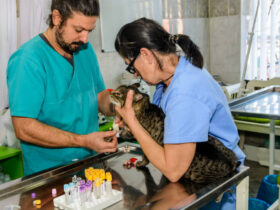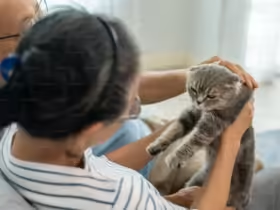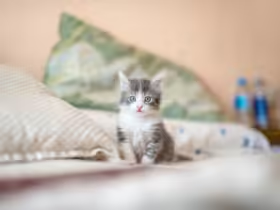When it comes to pet health, cat acne might not be the first thing that comes to mind. Yet, this common condition can affect cats of all ages and breeds. Understanding what causes cat acne, recognizing its symptoms, and knowing how to treat and prevent it can ensure your feline friend stays comfortable and healthy. Here’s a comprehensive guide on cat acne: its causes, signs, and solutions.
What Is Cat Acne?
Cat acne is a condition where the skin follicles on a cat’s chin and lips become inflamed and clogged. This leads to the formation of comedones (blackheads), pustules, and in severe cases, painful sores. Although it may not seem serious, untreated cat acne can lead to more significant infections and discomfort.
Causes of Cat Acne
Understanding the causes of cat acne is crucial for prevention and treatment. Several factors can contribute to the development of acne in cats:
1. Poor Hygiene
Cats are fastidious groomers, but sometimes they can’t keep up with every nook and cranny. Dirt, oils, and bacteria can build up on the chin and lips, leading to clogged pores and acne.
2. Plastic Bowls
Plastic food and water bowls are notorious for harboring bacteria, which can contribute to acne. Plastic is porous and can become scratched, making it an ideal environment for bacterial growth.
3. Hormonal Changes
Just like humans, cats can experience hormonal changes that affect their skin. Young cats going through puberty or older cats with hormonal imbalances may be more prone to acne.
4. Allergies
Food allergies or sensitivities can lead to skin inflammation and acne. Identifying and removing allergens from your cat’s diet can help manage this issue.
5. Bacterial or Fungal Infections
Secondary infections from bacteria or fungi can aggravate acne. If your cat has a compromised immune system or underlying health issues, they might be more susceptible.
6. Stress
Stress can weaken your cat’s immune system, making it harder for them to fend off minor skin irritations and infections. This can contribute to acne outbreaks.
Symptoms of Cat Acne
Recognizing the symptoms of cat acne can help you address the issue before it becomes severe. Here are common signs to look for:
1. Blackheads and Pimples
The most noticeable symptom of cat acne is the appearance of blackheads or pimples on the chin and lower lip. These can vary in size and may be filled with pus.
2. Redness and Swelling
Inflammation around the affected area can cause redness and swelling. The skin may look irritated or puffy.
3. Crusty or Scabby Skin
In more severe cases, the acne can develop into scabs or crusts. This can be painful for your cat and may cause them to scratch or rub their face more frequently.
4. Discomfort or Itching
Cats with acne may show signs of discomfort or itching. You might notice them scratching at their chin or rubbing their face against objects.
5. Foul Odor
A bacterial infection can sometimes cause a foul odor coming from the affected area. This is a sign that the acne may be more severe and needs prompt attention.
Diagnosing Cat Acne
If you suspect your cat has acne, a visit to the veterinarian is essential for a proper diagnosis. Your vet will conduct a physical examination and may perform additional tests, such as skin scrapings or cultures, to rule out other conditions like ringworm or bacterial infections.
Treatment Options for Cat Acne
Once diagnosed, treating cat acne involves addressing both the symptoms and the underlying causes. Here are common treatment options:
1. Topical Treatments
Your vet may recommend topical treatments to reduce inflammation and infection. These could include medicated shampoos, ointments, or wipes specifically formulated for feline skin.
2. Antibiotics
In cases where a bacterial infection is present, your vet may prescribe antibiotics. It’s essential to follow the full course of treatment to ensure the infection is completely eradicated.
3. Change of Diet
If food allergies or sensitivities are suspected, your vet may suggest a diet change. This could involve switching to hypoallergenic cat food or eliminating certain ingredients.
4. Switch to Non-Plastic Bowls
To prevent future outbreaks, switch to stainless steel or ceramic food and water bowls. These materials are less likely to harbor bacteria and are easier to clean.
5. Regular Grooming
Regular grooming can help keep your cat’s skin clean and reduce the buildup of oils and dirt. However, avoid over-bathing, as it can strip essential oils from the skin.
6. Stress Management
If stress is a contributing factor, addressing the sources of stress and creating a calm environment can help improve your cat’s overall well-being. Consider using pheromone diffusers or calming supplements as recommended by your vet.
Prevention Tips
Preventing cat acne involves a combination of good hygiene and proactive care:
1. Maintain Clean Bowls
Ensure that your cat’s food and water bowls are washed daily. Consider using stainless steel or ceramic bowls, which are less likely to harbor bacteria.
2. Regular Vet Checkups
Regular veterinary visits can help catch any underlying issues early and provide ongoing support for managing your cat’s skin health.
3. Monitor Diet
Keep an eye on your cat’s diet and be aware of any changes in their skin condition. Consult your vet before making significant changes to their diet.
4. Stress Reduction
Create a stress-free environment for your cat. Provide enrichment, regular playtime, and a safe, comfortable space for them to retreat.
5. Grooming Routine
Incorporate regular grooming into your cat’s routine to help maintain clean skin. Brush your cat regularly to remove excess oils and dirt.
When to Seek Professional Help
If your cat’s acne doesn’t improve with home care, or if you notice signs of severe infection, it’s important to seek veterinary help. Persistent or severe cases may require more intensive treatment and a thorough evaluation of underlying health issues.











Leave a Reply